























|
Russian Clothing in Period Art
Updated
25 February 2012
These are period illustrations that seemed helpful for illustrating medieval Russian clothing. Clicking on the illustrations will open up the full-size.
I've always been afraid of period illustrations, especially icons, since many are so "iconographic" that they don't seem to reflect actual Russian clothing of the period. However, I've recently gotten access to more illustrations and they seem fairly useful. So here goes...
Go to Russian Manuscripts and Period Sources to see more images.
11th Century Fresco of Irene/Ingegerd and her daughters from St. Sophia's, Kiev.
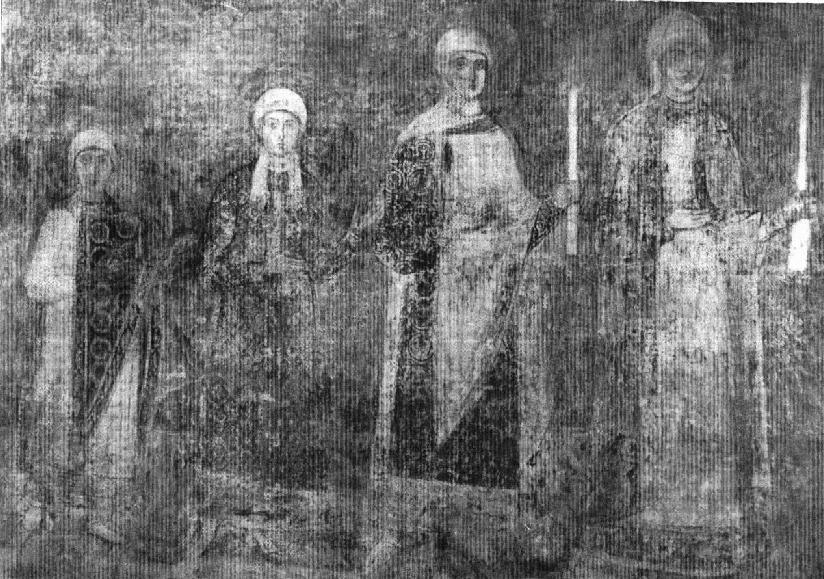 Grand Princess Irene (Ingigerd) seems to be wearing a shuba-type garment over her shoulders, like a couple of the men in the fresco discussed below. She also seems to be wearing a wide-sleeved dalmatica if you look at her left arm carefully. Her eldest and youngest daughters are wearing edged cloaks fastened over the right shoulder, like the men in the fresco below. All the women are wearing white veils (ubrusy) and the second youngest daughter has the "tails" of the scarf pulled forward onto her chest. This second youngest daughter seems to be wearing just a rich rubakha/tunic (unlike the other women who are wearing cloaks or coats). Richly patterned fabrics and garment borders are visible.
Grand Princess Irene (Ingigerd) seems to be wearing a shuba-type garment over her shoulders, like a couple of the men in the fresco discussed below. She also seems to be wearing a wide-sleeved dalmatica if you look at her left arm carefully. Her eldest and youngest daughters are wearing edged cloaks fastened over the right shoulder, like the men in the fresco below. All the women are wearing white veils (ubrusy) and the second youngest daughter has the "tails" of the scarf pulled forward onto her chest. This second youngest daughter seems to be wearing just a rich rubakha/tunic (unlike the other women who are wearing cloaks or coats). Richly patterned fabrics and garment borders are visible.
Grand Princess Irene was a Swedish princess, named Ingegerd, who married Grand Prince Yaroslav the Wise. Her daughters married Kings of France, Hungary and Norway.
I'm hoping to find a better reproduction of this image.
17th Century Copy of 11th Century Fresco of Family of Yaroslav the Wise from St. Sophia's, Kiev.

The central male figure (Saint Vladimir, converter of Rus and Yaroslav's father) seems to be wearing a long robe under a fur-lined coat (shuba) with very long sleeves over his shoulders. The figure of Yaroslav, presenting a miniature of the cathedral to his father, is wearing a belted, long-sleeved robe, with decorative bands at hem, wrist and possibly upper arm and a ornate cloak with decorated bands along the edge. His eldest son is wearing a shuba over his shoulders like Saint Vladimir (but without the fur lining) over a long robe like his father's. There is a suggestion of a 3/4 length wide sleeve on his left arm, indicating he may be wearing a "dalmatica" as well. Two of the remaining sons are dressed much like their father, Yaroslav. One is wearing a very rich long-sleeved robe with a decorated band down the front and no cloak or coat. They all seem to have chin to shoulder-length "page boy" hair cuts under their fur hats, but only Yaroslav and Vladimir seem to have beards.
Grand Princess Irene (Ingigerd), and her eldest daughter, are wearing edged cloaks fastened in the middle front, unlike the men who have theirs fastened over the right shoulder. Both women are wearing white veils (ubrusy) under their headresses. The eldest daughter is clearly wearing a wide-sleeved "dalmatica" over her long-sleeved robe. The other daughters are wearing rich robes with vertical front trim like one of their brothers although wide circular collars are suggested on theirs, while their brother's may have a turned down collar. The girls' fur hats are similar to the boys, but not as tall.
In all cases, the outermost garment worn is made of very rich, patterned fabric, while "lower" garments are much simpler. Also note the length of all the robes, all the feet, except those of Saint Vladimir, are clearly visible.
Grand Prince Yaroslav the Wise lived in the 11th century. One of his sons was Svyatoslav, see below. The illustration is a 17th century Dutch copy (by Abraham van Westfeldt) of an 11th century fresco from St. Sophia cathedral in Kiev (that Yaroslav built) that was later damaged. I'm looking for better reproductions of this image.
Manuscript Illustration of Family of Grand Prince Svyatoslav.
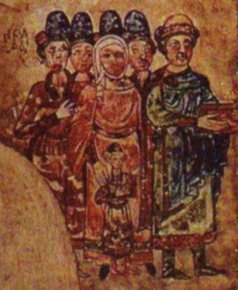 This family is more simply dressed than the family above. The Grand Princess is wearing a belted, wide-sleeved, calf-length "dalmatica" over her ankle-length robe. She is wearing a wide circular collar and a white veil. The Grand Prince wears a fairly short cloak fastened over his right shoulder over a calf-length robe and, probably, boots. All of the boys, the little one in front and the 4 big ones in back, are wearing calf length robes with turned down (?) collars. All the men are wearing hats with odd protrusions on the side (ear flaps?). Note that the Grand Prince's hat is shorter than his sons'. The Grand Prince and the older son right behind him both seem to be bearded, and their hair looks shorter than the men's hair in Yaroslav's family.
This family is more simply dressed than the family above. The Grand Princess is wearing a belted, wide-sleeved, calf-length "dalmatica" over her ankle-length robe. She is wearing a wide circular collar and a white veil. The Grand Prince wears a fairly short cloak fastened over his right shoulder over a calf-length robe and, probably, boots. All of the boys, the little one in front and the 4 big ones in back, are wearing calf length robes with turned down (?) collars. All the men are wearing hats with odd protrusions on the side (ear flaps?). Note that the Grand Prince's hat is shorter than his sons'. The Grand Prince and the older son right behind him both seem to be bearded, and their hair looks shorter than the men's hair in Yaroslav's family.
Grand Prince Sviatoslav lived in the 11th century. The illustration comes from the Izbornik of Svyatoslav.
11th Century Man provided by Predslava Vydrina

Quite the funny little hat. Note also the hairstyle, beard and collar detail.
14th Century Novgorod icon of the Nativity of the Virgin - found by Kseniia Smolnianina.
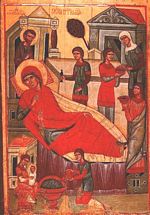 It looks like most of the women are wearing knee-length navershniki with wide trim at the collar, short sleeves and hem. I can't quite tell if the maidens' hair is braided or not. One woman is wearing a white ubrus. The baby Jesus is swaddled. The Mother of God is in her usual iconographic attire - long red mantle pulled hoodlike over the head, blue rubakha, possibly some sort of headcovering (povoinik?) under her mantle.
It looks like most of the women are wearing knee-length navershniki with wide trim at the collar, short sleeves and hem. I can't quite tell if the maidens' hair is braided or not. One woman is wearing a white ubrus. The baby Jesus is swaddled. The Mother of God is in her usual iconographic attire - long red mantle pulled hoodlike over the head, blue rubakha, possibly some sort of headcovering (povoinik?) under her mantle.
Early 14th Century Pskov icon of Holy Ul'yana - from the Partizan website.
 Image of the saint strongly resembles iconic representation of the Mother of God with the draped headcovering over a white povoinik (?). Most interesting is that her ears are visible, possibly with earrings.
Image of the saint strongly resembles iconic representation of the Mother of God with the draped headcovering over a white povoinik (?). Most interesting is that her ears are visible, possibly with earrings.
14th Cent. Sculpture on metal door from Sofia Church in Novgorod - from the Partizan website.
 Image of the master metal worker shows him in a knee length tunic (svita? zipun?) made of patterned fabric with trim down the front, at the wrists, and around the hem. He also wears a cross around his neck, a waist sash and boots.
Image of the master metal worker shows him in a knee length tunic (svita? zipun?) made of patterned fabric with trim down the front, at the wrists, and around the hem. He also wears a cross around his neck, a waist sash and boots.
14th Century Icon of Saint George and his Life.
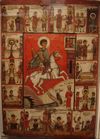 This image shows the saint in stylized armor and a cloak. The images from his life around the border are, perhaps, more informative although the poor quality image makes it difficult to work out the details.
This image shows the saint in stylized armor and a cloak. The images from his life around the border are, perhaps, more informative although the poor quality image makes it difficult to work out the details.
Detail of the above.
 Three different haircuts.
Three different haircuts.
Detail of the above.
 More different haircuts and a crowned head.
More different haircuts and a crowned head.
14th Century Icon of Saints Boris and Gleb and their Life.
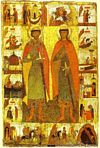 This image shows the princes in knee-length belted tunics and cloaks with richly decorated borders. One wears a rich wide collar.
This image shows the princes in knee-length belted tunics and cloaks with richly decorated borders. One wears a rich wide collar.
Detail of the above.
 The brothers have distinctly different haircuts and Boris is bearded while Gleb is clean-shaven.
The brothers have distinctly different haircuts and Boris is bearded while Gleb is clean-shaven.
15th Century Icon of Saints Vladimir, Boris and Gleb
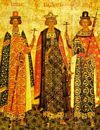 The images show wonderfully rich fabrics with wide decorated edging. Boris and Vladimir, on the left and in the middle, have outer garments (shuby?) with very long sleeves are worn over the shoulders, cloak-like. Vladimir's is fur-lined and is worn over a wide-long-sleeved outer tunic over his rich rubakha. Gleb on the right wears an old-fashioned cloak over a wide-long-sleeved rich outer tunic over his rich rubakha.
The images show wonderfully rich fabrics with wide decorated edging. Boris and Vladimir, on the left and in the middle, have outer garments (shuby?) with very long sleeves are worn over the shoulders, cloak-like. Vladimir's is fur-lined and is worn over a wide-long-sleeved outer tunic over his rich rubakha. Gleb on the right wears an old-fashioned cloak over a wide-long-sleeved rich outer tunic over his rich rubakha.
Radzivill Chronicle - 15th Century, from a UNESCO project, the Partizan webpage and anywhere else I can find them.
 The supervisor (Prince Andrei Iur'evich Bogoliubskii of Rostov) sitting on the left is wearing a rounded cap and a long robe (rubakha? svita? other?) with trim at collar, wrists and hem and long narrow sleeves. The laborers are wearing knee-length tunics (rubakhas?) and trousers that match their footwear (or hosen, I suppose), except for the one in the middle who looks like his legs might be naked! The matching footwear might just be artistic simplification. [UNESCO]
The supervisor (Prince Andrei Iur'evich Bogoliubskii of Rostov) sitting on the left is wearing a rounded cap and a long robe (rubakha? svita? other?) with trim at collar, wrists and hem and long narrow sleeves. The laborers are wearing knee-length tunics (rubakhas?) and trousers that match their footwear (or hosen, I suppose), except for the one in the middle who looks like his legs might be naked! The matching footwear might just be artistic simplification. [UNESCO]
 Prince Andrei leads his troops on campaign, changing the color of his hat and legwear, and exchanging his long robes for a knee-length tunic. The soldiers have added helmets and possibly torso armor to their tunics and trousers. [UNESCO]
Prince Andrei leads his troops on campaign, changing the color of his hat and legwear, and exchanging his long robes for a knee-length tunic. The soldiers have added helmets and possibly torso armor to their tunics and trousers. [UNESCO]
 Prince Andrei gives thanks before the icon of the Virgin. He is wearing an opashen' with a front closure with the horizontal loops, a wide black collar, and golden trim at the hem, with his arms through the extra armhole, near the underarm, leaving the rest of his very long sleeves to hang down at his site. His golden rounded cap now has black trim around the cuff. One of his companions is similarly dressed. [UNESCO]
Prince Andrei gives thanks before the icon of the Virgin. He is wearing an opashen' with a front closure with the horizontal loops, a wide black collar, and golden trim at the hem, with his arms through the extra armhole, near the underarm, leaving the rest of his very long sleeves to hang down at his site. His golden rounded cap now has black trim around the cuff. One of his companions is similarly dressed. [UNESCO]
 Prince Andrei sits receiving the Novgorod ambassador wearing a long robe with wide sleeves, and white trim down the front (not seen in the first robe!) and at the cuffs and hem. He also seems to be wearing a wide black collar. Notice the curly hair under his green hat! The Novgorod ambassador seems to be wearing a similar robe, albeit in greenish-bluish gray with gold trim and collar. His hat is a bit more dashing with a higher, less rounded crown, and a turned up golden cuff.
The Prince's son (on the right being taken away to be prince of Novgorod!) is wearing a red knee-length tunic with golden trim over his green trousers/hose. His new "friends" are wearing similar tunics, but with evidence of an offset neck opening in the vertical line of gold trim comming down from the left side of their collars. One also is wearing golden boots over his legwear. [UNESCO]
Prince Andrei sits receiving the Novgorod ambassador wearing a long robe with wide sleeves, and white trim down the front (not seen in the first robe!) and at the cuffs and hem. He also seems to be wearing a wide black collar. Notice the curly hair under his green hat! The Novgorod ambassador seems to be wearing a similar robe, albeit in greenish-bluish gray with gold trim and collar. His hat is a bit more dashing with a higher, less rounded crown, and a turned up golden cuff.
The Prince's son (on the right being taken away to be prince of Novgorod!) is wearing a red knee-length tunic with golden trim over his green trousers/hose. His new "friends" are wearing similar tunics, but with evidence of an offset neck opening in the vertical line of gold trim comming down from the left side of their collars. One also is wearing golden boots over his legwear. [UNESCO]
 These women are wearing wide-sleeved outer robes (letnik) with contrasting trim at neck, wrist and hem. Notice there doesn't seem to be any trim down the center front, nor are the sleeves split open, the way later Muscovite letnik sleeves apparently were.. I can't make out their headdresses, if any. [Partizan Woman]
These women are wearing wide-sleeved outer robes (letnik) with contrasting trim at neck, wrist and hem. Notice there doesn't seem to be any trim down the center front, nor are the sleeves split open, the way later Muscovite letnik sleeves apparently were.. I can't make out their headdresses, if any. [Partizan Woman]
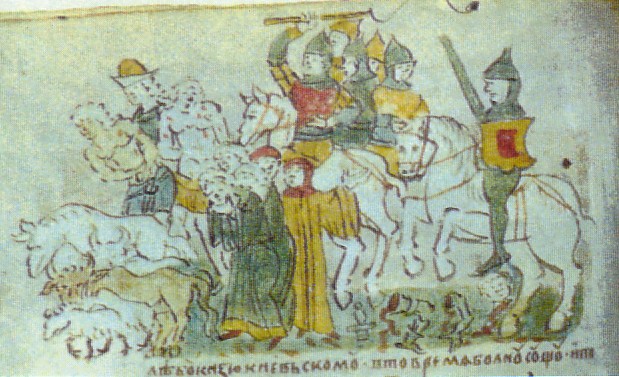 These women are also wearing wide-sleeved outer robes. The yellow gown on the right seems to show trim down the center front. Notice that the sleeves are not split open. A couple of the women are wearing nice red head wraps. The two male prisoners on the left seem to have been stripped down to their undershorts - light blue-gray and gold.
These women are also wearing wide-sleeved outer robes. The yellow gown on the right seems to show trim down the center front. Notice that the sleeves are not split open. A couple of the women are wearing nice red head wraps. The two male prisoners on the left seem to have been stripped down to their undershorts - light blue-gray and gold.
 Most of the garments in the image are the same as already noted from this source. Most interesting are the victims in the center of the image in various states of undress. One of them, on the right side, is having an upper garment removed revealing another tunic underneath. The one on the left having his tunic removed seems to have already lost his trousers, unfortunately. (So no verdict on the trousers vs hosen debate with this image.) No undershorts, either. [Partizan Man]
Most of the garments in the image are the same as already noted from this source. Most interesting are the victims in the center of the image in various states of undress. One of them, on the right side, is having an upper garment removed revealing another tunic underneath. The one on the left having his tunic removed seems to have already lost his trousers, unfortunately. (So no verdict on the trousers vs hosen debate with this image.) No undershorts, either. [Partizan Man]
 These men are wearing long opasheni with their arms through the sleeve slits. [Partizan Man]
These men are wearing long opasheni with their arms through the sleeve slits. [Partizan Man]
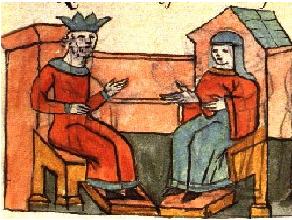 The Emperor Constantine is wearing a long, narrow-sleeved robed with blue trim at collar, cuffs and hem. Princess Olga is wearing a blue headdress and robe with a red short cloak (?). [Predslava]
The Emperor Constantine is wearing a long, narrow-sleeved robed with blue trim at collar, cuffs and hem. Princess Olga is wearing a blue headdress and robe with a red short cloak (?). [Predslava]
Images from 15th Century icon "Praying Novgorodtsy" from Partizan website.
 Boyarina wearing a white polotentse (head scarf) that leaves her ears uncovered, an odnoryadka (similar to opasheni), over a lighter colored letnik with contrasting trim at the wrist, apparently with her arms through the sleeve-slits of the odnoryadka.
Boyarina wearing a white polotentse (head scarf) that leaves her ears uncovered, an odnoryadka (similar to opasheni), over a lighter colored letnik with contrasting trim at the wrist, apparently with her arms through the sleeve-slits of the odnoryadka.
 Boys in red-trimmed rubakhas, tied with red cord belts, and red boots (?).
Boys in red-trimmed rubakhas, tied with red cord belts, and red boots (?).
 Detail of men's leg wear - red boots over trousers or, perhaps, hose.
Detail of men's leg wear - red boots over trousers or, perhaps, hose.
 Men wearing opasheni over their shoulders like cloaks, on top of svitas, and red legwear.
Men wearing opasheni over their shoulders like cloaks, on top of svitas, and red legwear.
15th Century icon of The Forty Holy Martyrs - from the Partizan website.
 Under trousers! Most ankle length, one knee length. They seem to sit pretty low on the hips.
Under trousers! Most ankle length, one knee length. They seem to sit pretty low on the hips.
15th Century fresco in Uspenskij Cathedral, Vladimir - from the Partizan website.
 The woman in the crown, veil and wide circular collar with trim down the front of her wide-sleeved (?) gown is probably the Grand Princess. The other women seem to be wearing mantles as their outer garments. The woman just to the right of the Grand Princess has her cloak fastened in the center front with a circular connection (cloak pin?) She also has an odd headdress that looks a bit like a mini-crown, or perhaps just an ochle'e (forehead) decoration on her headdress. Two of the women to the left of the Grand Princess also have interesting headdress, presumably a form of kika with ubrus. Compare with the woman in light green standing behind the tsaritsa in the second Soloveckom image near the bottom of this page.
The woman in the crown, veil and wide circular collar with trim down the front of her wide-sleeved (?) gown is probably the Grand Princess. The other women seem to be wearing mantles as their outer garments. The woman just to the right of the Grand Princess has her cloak fastened in the center front with a circular connection (cloak pin?) She also has an odd headdress that looks a bit like a mini-crown, or perhaps just an ochle'e (forehead) decoration on her headdress. Two of the women to the left of the Grand Princess also have interesting headdress, presumably a form of kika with ubrus. Compare with the woman in light green standing behind the tsaritsa in the second Soloveckom image near the bottom of this page.
15th Century icon of "Life of Metropolitan Alex" - from the Partizan website.
 The main figure in this image has a knee-length svita of patterned fabric with a black collar, a golden belt, and trim down the front, and at the cuffs and hem. He wears it over a red tunic with gold trim, dark patterned trousers and boots. He has a white rounded-cone cap with narrow red cuff. His companion is wearing either a long opashen or cloak over his red knee-length tunic.
The main figure in this image has a knee-length svita of patterned fabric with a black collar, a golden belt, and trim down the front, and at the cuffs and hem. He wears it over a red tunic with gold trim, dark patterned trousers and boots. He has a white rounded-cone cap with narrow red cuff. His companion is wearing either a long opashen or cloak over his red knee-length tunic.
15th Century Hat provided by Predslava Vydrina
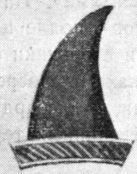
Another impressive hat. [Giliarovskaia]
Icon (15th century?) of "Novgorodians fighting the Suzdalians" - from the Partizan website.
 This man is wearing a shorter version of the opashen, over a svita that is upper calf length (i.e. "knee-length").
This man is wearing a shorter version of the opashen, over a svita that is upper calf length (i.e. "knee-length").
 A closer look at a couple versions of the most popular hat I've been seeing in these images. The one on the left is headed for a nice point. The other two have an oddly rounded high crown. The man in the middle has a nice two-toned cuff on his hat.
A closer look at a couple versions of the most popular hat I've been seeing in these images. The one on the left is headed for a nice point. The other two have an oddly rounded high crown. The man in the middle has a nice two-toned cuff on his hat.
Old Russian Miniatures, published in 1933 - includes 15th-17th Century miniatures. Made available on-line by Paul Goldschmidt.
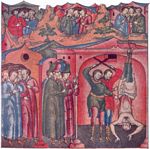 A particularly interesting illustration of a boyar being punished. He seems to have his linen undertunic pulled down (up?) to his waist hanging magically up over his trousers/hose and boots. The two men with the sticks are wearing knee-length tunics with different collars (we're starting to really leave my time period here, but I believe one on the left could be a zipun or rubakha, I suppose, and the other could be a chuga/kaftan). The other boyars are wearing long robes which look like shubas or feryazi, again, I'm rather out of my period here. Illustration from the Life of Sergei (Zhitie Sergii), pg 54, Russian State Library.
A particularly interesting illustration of a boyar being punished. He seems to have his linen undertunic pulled down (up?) to his waist hanging magically up over his trousers/hose and boots. The two men with the sticks are wearing knee-length tunics with different collars (we're starting to really leave my time period here, but I believe one on the left could be a zipun or rubakha, I suppose, and the other could be a chuga/kaftan). The other boyars are wearing long robes which look like shubas or feryazi, again, I'm rather out of my period here. Illustration from the Life of Sergei (Zhitie Sergii), pg 54, Russian State Library.
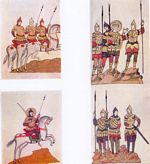 Soldiers with pointed helmets and with various stylized versions of torso protection worn over knee-length tunics, trousers and boots. Notice the crown (and halo) on one of the figures in the upper right. That illustration is for the text, "The kings of the earth take their stand/And the rulers take counsel together/Against the Lord and against His Anointed." One of the soldiers in the lower right seems to be wearing onuchi (legwraps) on his lower legs, and the two soldiers with him have shoes on instead of boots. From Godunov Psalter, p68ob.
Soldiers with pointed helmets and with various stylized versions of torso protection worn over knee-length tunics, trousers and boots. Notice the crown (and halo) on one of the figures in the upper right. That illustration is for the text, "The kings of the earth take their stand/And the rulers take counsel together/Against the Lord and against His Anointed." One of the soldiers in the lower right seems to be wearing onuchi (legwraps) on his lower legs, and the two soldiers with him have shoes on instead of boots. From Godunov Psalter, p68ob.
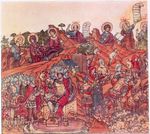 Obviously a later period illustration that suffers from being rather "iconographic". That is, the soldiers are wearing Roman-style breast plates and skirts, like the old Byzantine icons, and the civilians, what little we can see of them, seem to be in generic "Bible costume" rather than specifically Russian dress.
Obviously a later period illustration that suffers from being rather "iconographic". That is, the soldiers are wearing Roman-style breast plates and skirts, like the old Byzantine icons, and the civilians, what little we can see of them, seem to be in generic "Bible costume" rather than specifically Russian dress.
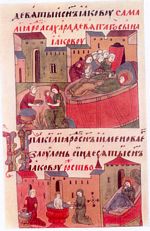 Birth scenes are great places to find illustration of women. I particularly notice the wide golden collars, multiple colors of ubrusi (head scarves), the short or rolled up sleeves, and the women with wide golden trim around their upper arms - short-sleeved overgarments like the woman with the red-swaddled (!) baby or just decorations on the upper part of long sleeves? See below, where the garments seem to clearly be long sleeved with upper arm trim.
Birth scenes are great places to find illustration of women. I particularly notice the wide golden collars, multiple colors of ubrusi (head scarves), the short or rolled up sleeves, and the women with wide golden trim around their upper arms - short-sleeved overgarments like the woman with the red-swaddled (!) baby or just decorations on the upper part of long sleeves? See below, where the garments seem to clearly be long sleeved with upper arm trim.
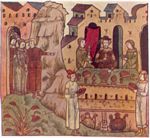 A Wedding Feast is another place where women get to appear. One of these is dressed similar to the above illustration - wide golden trim at collar, upper arms and wrists with narrow sleeves, possibly also some trim at the bottom hem, with another garment peeking out from underneath there. The two women at the table have wide sleeves and wide golden collars and cuffs (dalmatiki? letniki?). The end of a long narrow sleeve with a golden cuff is visible inside the wide outer sleeves of the woman on the left at the table.
A Wedding Feast is another place where women get to appear. One of these is dressed similar to the above illustration - wide golden trim at collar, upper arms and wrists with narrow sleeves, possibly also some trim at the bottom hem, with another garment peeking out from underneath there. The two women at the table have wide sleeves and wide golden collars and cuffs (dalmatiki? letniki?). The end of a long narrow sleeve with a golden cuff is visible inside the wide outer sleeves of the woman on the left at the table.
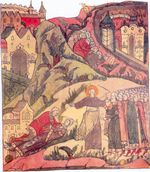 More upper arm trim on long narrow sleeves. The woman on the lower left has similar trim on her wide-sleeve gown. Moses, with the halo, is depicted "iconographically". Two of the men on the lower right are wearing opashen-like garments over their shoulders over long robes with the long narrow sleeves and trim at the collar, upper arm, cuffs and hem. The man behind them is wearing a mantle fastened over his left (!) shoulder.
More upper arm trim on long narrow sleeves. The woman on the lower left has similar trim on her wide-sleeve gown. Moses, with the halo, is depicted "iconographically". Two of the men on the lower right are wearing opashen-like garments over their shoulders over long robes with the long narrow sleeves and trim at the collar, upper arm, cuffs and hem. The man behind them is wearing a mantle fastened over his left (!) shoulder.
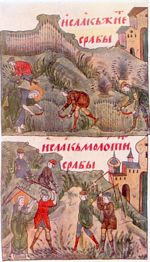 Here again, the saint (Isaac) is depicted rather "iconographically." His servants are wearing knee-length tunics with long narrow sleeves and rather subtle trim a the collar, uper arms, wrists and hem. Four of them have the front of their skirts divided in an odd way, one revealing a blue tunic under his short-sleeved (?!) red one. They are also wearing rather floppy looking hats with narrow cuffs, trouses and boots.
Here again, the saint (Isaac) is depicted rather "iconographically." His servants are wearing knee-length tunics with long narrow sleeves and rather subtle trim a the collar, uper arms, wrists and hem. Four of them have the front of their skirts divided in an odd way, one revealing a blue tunic under his short-sleeved (?!) red one. They are also wearing rather floppy looking hats with narrow cuffs, trouses and boots.
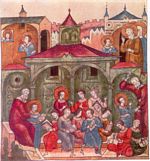 Boys at school! They are wearing long robes with long narrow sleeves with wide golden trim at collar, and wrists. Wide golden belts are visible on some of them. I can't quite tell if they're wearing boots or shoes. The note the shuba-like collars on the men's robes. I can just see a little bit of Saint Sergei's mother in the upper right, behind his father - white ubrus and blue robe.
Boys at school! They are wearing long robes with long narrow sleeves with wide golden trim at collar, and wrists. Wide golden belts are visible on some of them. I can't quite tell if they're wearing boots or shoes. The note the shuba-like collars on the men's robes. I can just see a little bit of Saint Sergei's mother in the upper right, behind his father - white ubrus and blue robe.
Tsaritsa Alexandra from 16th Century Icon - from Partizan website.
 The tsaritsa is wearing a golden crown over a veil, a dark mantle (or opashen worn like a cloak?) and a wide-sleeved outer robe (letnik) with contrasting trim down the front and at the neck, wrist (and probably hems).
The tsaritsa is wearing a golden crown over a veil, a dark mantle (or opashen worn like a cloak?) and a wide-sleeved outer robe (letnik) with contrasting trim down the front and at the neck, wrist (and probably hems).
The Life of Saint Aleksandr Nevskii - 16th century.
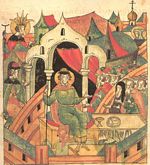 Crowned figure with black fur collar and red mantle in upper left. Woman with blue ubrus or pointed hood (? nun?) and dark robe in upper right. Lower left figure with rounded red hat with black fur trim, black fur collar and green mantle. Central figure (Prince Alexander Nevskij) in decorated round gold hat with black fur trim, reddish mantle and green robe with golden trim and belt. Populace in different style of hat with the monk in his black hood.
Crowned figure with black fur collar and red mantle in upper left. Woman with blue ubrus or pointed hood (? nun?) and dark robe in upper right. Lower left figure with rounded red hat with black fur trim, black fur collar and green mantle. Central figure (Prince Alexander Nevskij) in decorated round gold hat with black fur trim, reddish mantle and green robe with golden trim and belt. Populace in different style of hat with the monk in his black hood.
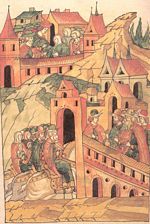 More hats with the split cuffs in the lower figures. Children in swaddling clothes. Women in ubrusy and cloaks. I believe the men in the wide-cuffed hats in the upper part of the picture are supposed to be the Germans taking over the city of Pskov. (The figures in the lower left are refugees from Pskov outside the gates of Novgorod.)
More hats with the split cuffs in the lower figures. Children in swaddling clothes. Women in ubrusy and cloaks. I believe the men in the wide-cuffed hats in the upper part of the picture are supposed to be the Germans taking over the city of Pskov. (The figures in the lower left are refugees from Pskov outside the gates of Novgorod.)
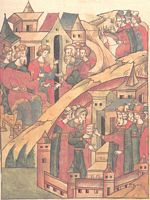 The princes on the left are distinguished by their golden hats. The old prince has an interesting knee-length outer garment. Most of the men seem to be wearing opashen-type garments with very long sleeves (and upper arm trim) worn over their shoulders like cloaks
The princes on the left are distinguished by their golden hats. The old prince has an interesting knee-length outer garment. Most of the men seem to be wearing opashen-type garments with very long sleeves (and upper arm trim) worn over their shoulders like cloaks
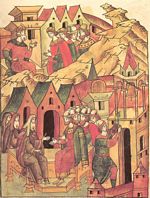 Most garments in this image are the same as in the above. However, we see some examples of high-ranking (one is the Archbishop) clerical clothing in the lower left, and the bell ringer on the lower right is wearing a somewhat floppy-looking hat, a knee-length tunic, and possibly dark lower leg wrappings (onuchi), which would seem to indicate that he is of lower Status.
Most garments in this image are the same as in the above. However, we see some examples of high-ranking (one is the Archbishop) clerical clothing in the lower left, and the bell ringer on the lower right is wearing a somewhat floppy-looking hat, a knee-length tunic, and possibly dark lower leg wrappings (onuchi), which would seem to indicate that he is of lower Status.
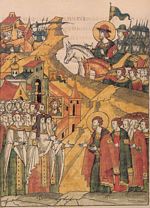 This image is distinguished by the depiction of clerical vestments (and a German in the upper left?). It is also interesting that Prince Alexander is greeting the clerical delegation hatless - perhaps because the text says, "O Lord, Thou who hast helped the meek David to overcome the aliens, and our faithful prince to do the same..."
This image is distinguished by the depiction of clerical vestments (and a German in the upper left?). It is also interesting that Prince Alexander is greeting the clerical delegation hatless - perhaps because the text says, "O Lord, Thou who hast helped the meek David to overcome the aliens, and our faithful prince to do the same..."
Povest' o Soloveskom Vosstanii - 17th century.
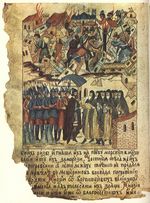 The upper figures basically look like the classic Russian soldiers with their cone-shaped fur-trimmed hats, knee-length tunics with the characteristic front closure, trousers and boots. The soldiers in the lower left are dressed the same way except for the addition of helmets and remarkably realistic chainmail shirts (some short-sleeved, one long-sleeve). Their leader and the clerics seem to be wearing cloaks. The leader also seems to be wearing trousers, perhaps with a red strip down the inner left leg (?!?). I can't quite make out what sort of robe he has on.
The upper figures basically look like the classic Russian soldiers with their cone-shaped fur-trimmed hats, knee-length tunics with the characteristic front closure, trousers and boots. The soldiers in the lower left are dressed the same way except for the addition of helmets and remarkably realistic chainmail shirts (some short-sleeved, one long-sleeve). Their leader and the clerics seem to be wearing cloaks. The leader also seems to be wearing trousers, perhaps with a red strip down the inner left leg (?!?). I can't quite make out what sort of robe he has on.
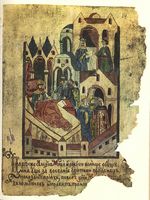 More women! The tsaritsa is quite distinctive in her gold crown, veil, golden barma (collar) and wide-sleeved outer robe (dalmatika) made of patterned blue fabric. (She appears twice.) The woman behind her in the lower group of figures has an interesting tall green headdress that looks rather like an ubrus over a kika-like foundation? The woman to the right has a simple white head scarf, wide black fur collar, patterned pink wide-sleeved robe. The tsar seems to be wearing the famous Cap of Monomakh, and a golden barma as part of his regalia.
More women! The tsaritsa is quite distinctive in her gold crown, veil, golden barma (collar) and wide-sleeved outer robe (dalmatika) made of patterned blue fabric. (She appears twice.) The woman behind her in the lower group of figures has an interesting tall green headdress that looks rather like an ubrus over a kika-like foundation? The woman to the right has a simple white head scarf, wide black fur collar, patterned pink wide-sleeved robe. The tsar seems to be wearing the famous Cap of Monomakh, and a golden barma as part of his regalia.
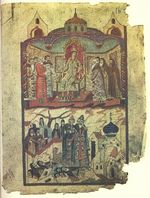 Here we have another example of the tsar's royal regalia. Notice that the men in his presence are hatless (except for the monks.) The fabrics look marvelous. The nobles in the lower group of figures have interesting golden decoration around the fur cuffs of their cone-shaped hats.
Here we have another example of the tsar's royal regalia. Notice that the men in his presence are hatless (except for the monks.) The fabrics look marvelous. The nobles in the lower group of figures have interesting golden decoration around the fur cuffs of their cone-shaped hats.
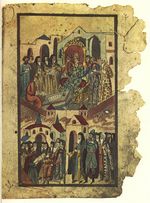 The green trousers with the red stripe are more clearly visible here, in the lower figures, along with knee-length tunic open to reveal a little of the lower garment. (He seems to be in trouble for something - notice the wrist shackles.)
The green trousers with the red stripe are more clearly visible here, in the lower figures, along with knee-length tunic open to reveal a little of the lower garment. (He seems to be in trouble for something - notice the wrist shackles.)
Let me know if you find any artwork that
you think should be shared here. These items can be hard to find and I appreciate the help.
Back to Russian Material
























|

|



































































































